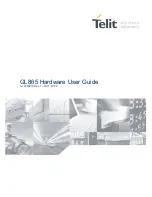
Power Management
48
Datasheet
4.3.1
Disabling Unused System Memory Outputs
Any system memory (SM) interface signal that goes to a memory module connector in
which it is not connected to any actual memory devices (such as SO-DIMM connector is
unpopulated, or is single-sided) is tri-stated. The benefits of disabling unused SM
signals are:
•
Reduced power consumption.
•
Reduced possible overshoot/undershoot signal quality issues seen by the processor
I/O buffer receivers caused by reflections from potentially un-terminated
transmission lines.
When a given rank is not populated, the corresponding chip select and CKE signals are
not driven.
At reset, all rows must be assumed to be populated, until it can be proven that they are
not populated. This is due to the fact that when CKE is tristated with an SO-DIMM
present, the SO-DIMM is not guaranteed to maintain data integrity.
4.3.2
DRAM Power Management and Initialization
The processor implements extensive support for power management on the SDRAM
interface. There are four SDRAM operations associated with the Clock Enable (CKE)
signals, which the SDRAM controller supports. The processor drives four CKE pins to
perform these operations.
4.3.2.1
Initialization Role of CKE
During power-up, CKE is the only input to the SDRAM that has its level is recognized
(other than the DDR3 reset pin) once power is applied. It must be driven LOW by the
DDR controller to make sure the SDRAM components float DQ and DQS during power-
up. CKE signals remain LOW (while any reset is active) until the BIOS writes to a
configuration register. Using this method, CKE is guaranteed to remain inactive for
much longer than the specified 200 micro-seconds after power and clocks to SDRAM
devices are stable.
4.3.2.2
Conditional Self-Refresh
The processor conditionally places memory into self-refresh in the package C3 and C6
low-power states.
When entering the Suspend-to-RAM (STR) state, the processor core flushes pending
cycles and then enters all SDRAM ranks into self refresh. In STR, the CKE signals
remain LOW so the SDRAM devices perform self-refresh.
The target behavior is to enter self-refresh for the package C3 and C6 states as long as
there are no memory requests to service. The target usage is shown in
.
Содержание PENTIUM P6000 MOBILE PROCESSOR -
Страница 179: ...Datasheet 179 Processor Pin and Signal Information Figure 8 26 rPGA Mechanical Package Sheet 2 of 2...
Страница 180: ...Processor Pin and Signal Information 180 Datasheet Figure 8 27 BGA Mechanical Package Sheet 1 of 2...
Страница 181: ...Datasheet 181 Processor Pin and Signal Information Figure 8 28 BGA Mechanical Package Sheet 2 of 2...
















































